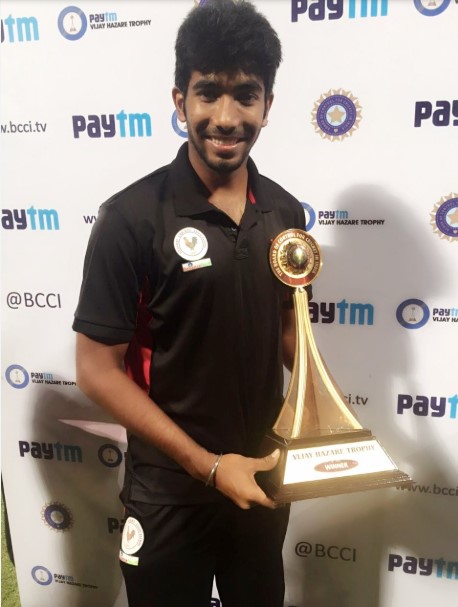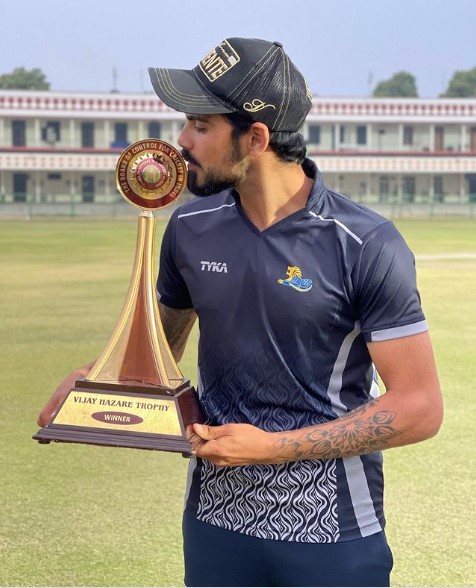The Vijay Hazare Trophy is one of India’s premier domestic limited-overs cricket tournaments, named after the legendary Indian cricketer Vijay Hazare, who played a key role in Indian cricket during the 1940s and 1950s. It is widely regarded as an important tournament that allows Indian cricketers to showcase their talent, aiming for selection to the national team in shorter formats like One Day Internationals (ODIs). The tournament provides a platform for both established and emerging players to gain invaluable experience and make their mark in Indian cricket.
The Vijay Hazare Trophy has evolved over the years, with several changes to its format, structure, and rules. In this article, we will take a deep dive into the history, structure, format, rules, and other essential aspects of the Vijay Hazare Trophy. We will break down how the tournament functions, how teams are organized, the stages of the competition, and what sets it apart from other domestic cricket tournaments in India. Additionally, we will provide tables that summarize key aspects of the tournament.

1. Overview of the Vijay Hazare Trophy
The Vijay Hazare Trophy is a 50-over domestic cricket competition, and it holds immense significance in Indian cricket. The tournament has been organized by the Board of Control for Cricket in India (BCCI) since its inception in 2002-03, and it provides a vital opportunity for players to hone their skills in the limited-overs format. The competition includes teams representing regional states and cricket associations from across the country.
The Vijay Hazare Trophy is a 50-over format tournament, making it an important stepping stone for Indian cricketers to prove their worth in the shorter format, as the competition closely mimics the structure of One Day International (ODI) cricket. Many players who have impressed in the Vijay Hazare Trophy have gone on to represent India at the international level, such as Rishabh Pant, Shubman Gill, Hardik Pandya, and Shreyas Iyer.
Historical Significance:
- Named After: Vijay Hazare, former Indian cricketer and a prominent figure in India’s early cricket history.
- Inception: 2002-03, with the first edition being played after Hazare’s passing in 2001.
- Initial Structure: The tournament started with just a few teams, mostly from the regional states.
2. Vijay Hazare Trophy Format: Structure and Stages

The Vijay Hazare Trophy has undergone several changes in its format since its inception. The tournament is currently structured in a league-cum-knockout format, with teams competing in round-robin stages followed by knockout rounds. Let’s take a closer look at the key stages of the tournament and how teams progress through the competition.
Number of Teams and Groups
The competition involves a large number of teams representing the states and regions of India. The total number of teams has increased over the years, and now more than 30 teams participate in the tournament. These teams are divided into groups based on geographical regions, and the group stage typically follows a round-robin format.
Group Stage
- Division of Groups: The teams are divided into Elite Groups and Plate Groups, based on their past performance and strength. The Elite Group consists of the top teams from previous seasons, while the Plate Group includes lower-ranked teams.
- Format: In the round-robin format, each team plays against all other teams in their respective group. Points are awarded for wins, and a tie or no-result may lead to shared points.
- Points Table: Teams earn points for each match win, and the points table is maintained to determine the top teams in each group.
Knockout Stage
After the group stage, the top teams from each group progress to the knockout phase. This is where the competition becomes intense, as only the best-performing teams will move forward to compete for the title.
- Quarter-finals: The top teams from each Elite Group and the best-performing teams from the Plate Group move to the quarter-finals.
- Semi-finals: The winners of the quarter-finals face off in the semi-finals.
- Final: The final match is played between the winners of the two semi-finals to determine the champion of the Vijay Hazare Trophy.
Stages and Structure of the Vijay Hazare Trophy

| Stage | Format | Description |
|---|---|---|
| Group Stage | Round-robin format | Teams are divided into Elite and Plate groups. Teams play against others in their group. |
| Knockout Stage | Quarter-finals, Semi-finals, Final | The top teams progress to knockout rounds, culminating in a final to decide the winner. |
| Elite Group | Top teams based on previous performance | Teams from strong cricketing regions compete in the Elite group. |
| Plate Group | Lower-ranked teams | Teams from weaker cricketing regions or lower-ranked teams compete here. |
Points System in Group Stage
To determine the standing of each team during the group stage, a points system is used. Teams earn points based on the result of each match. Here is the breakdown of the points system:
- Win: 4 points
- No Result / Abandoned: 2 points
- Tie: 2 points
- Loss: 0 points
- Bonus Point: 1 extra point can be awarded for teams that win with a certain run rate margin (in case of a high-scoring match).
Points System for the Group Stage

| Result | Points Awarded |
|---|---|
| Win | 4 points |
| Loss | 0 points |
| No Result | 2 points |
| Tie | 2 points |
| Bonus Point | 1 point |
Selection Criteria for Knockouts
The teams that finish on top of their respective groups advance to the knockout stages, with Elite Group teams usually having a higher chance of progression due to their better past performance. Here’s how the selection works:
- Top 2 teams from each Elite Group: These teams automatically progress to the knockout rounds.
- Top 2 teams from the Plate Group: The best teams from the Plate Group can also qualify for the quarter-finals if they have sufficient points.
Format for the Knockout Stage
The knockout stage is where the tournament becomes increasingly competitive, with matches being played in a do-or-die format. The stages are as follows:
- Quarter-finals: The top teams from the group stage compete against each other. Each match is a must-win for both sides.
- Semi-finals: The winners of the quarter-finals move on to the semi-finals.
- Final: The two semi-final winners face off in the final match to decide the overall champion.
Vijay Hazare Trophy Winner
The winner of the final match is crowned the champion of the Vijay Hazare Trophy for that season. The champion team is awarded the trophy and is recognized as the best limited-overs team in Indian domestic cricket for the year.

3. Rules of the Vijay Hazare Trophy
In addition to the tournament format, several important rules govern the Vijay Hazare Trophy. These rules ensure fairness and consistency across all matches and stages of the competition.
Match Duration
- Innings: Each team gets a maximum of 50 overs to bat. The second innings follows after the first innings, with a break in between.
- Powerplay: The match is played with specific restrictions during the Powerplay:
- Powerplay 1: The first 10 overs allow a maximum of 2 fielders outside the 30-yard circle.
- Powerplay 2: Overs 11-40 allow a maximum of 4 fielders outside the 30-yard circle.
- Powerplay 3: Overs 41-50 allow a maximum of 5 fielders outside the 30-yard circle.
Player Availability and Squad Composition
Each team in the Vijay Hazare Trophy is allowed to select a squad of 15 players, with only 11 players allowed to play in any given match. Teams must submit their final playing XI before the start of each match.
No-Result and Tie Scenarios
In the event of a no-result (due to weather or other uncontrollable factors), each team is awarded 2 points, and no further play is scheduled. In the case of a tie, the match is generally decided by a super over or, in some cases, the higher net run rate is used to determine the winner.
4. Key Players in Vijay Hazare Trophy
Over the years, many cricketers have gained significant recognition through their performances in the Vijay Hazare Trophy. Some key players who have made a mark in the competition include:
- Rishabh Pant: The wicketkeeper-batsman from Delhi has been a star performer, using the Vijay Hazare Trophy to boost his career.
- Shubman Gill: An emerging talent, Gill has been in excellent form in the tournament and is considered one of the future stars of Indian cricket.
- Shreyas Iyer: Another cricketer who has used the tournament as a platform to make an impact at the international level.

The Vijay Hazare Trophy is a cornerstone of Indian domestic cricket, offering a stage for young talents and experienced cricketers to showcase their abilities. The tournament’s format, with its group stages and knockout rounds, ensures that it is competitive and thrilling for players and spectators alike. With clear rules, a structured format, and the opportunity for players to progress to international cricket, the Vijay Hazare Trophy continues to play a pivotal role in shaping India’s cricketing future.
Also Read: The Boundary Length of MA Chidambaram Stadium in Chennai












